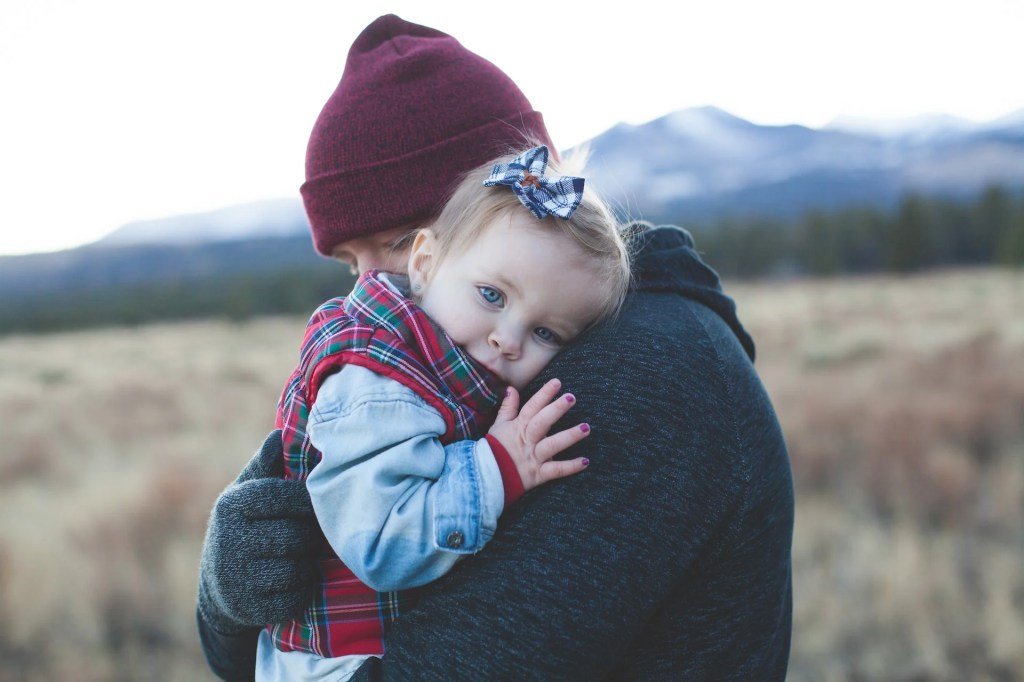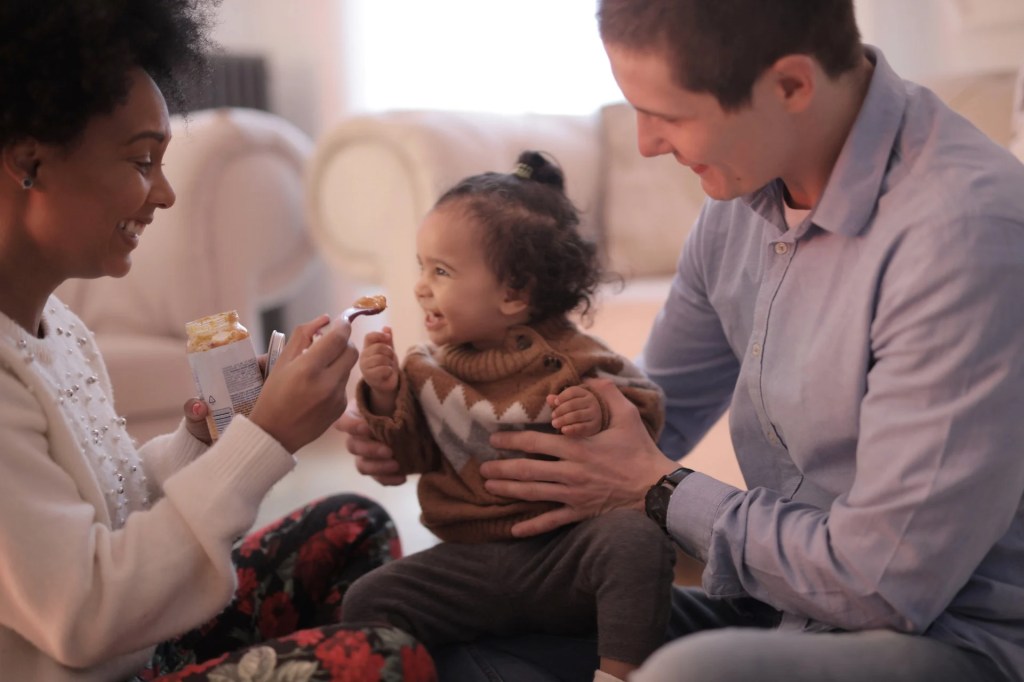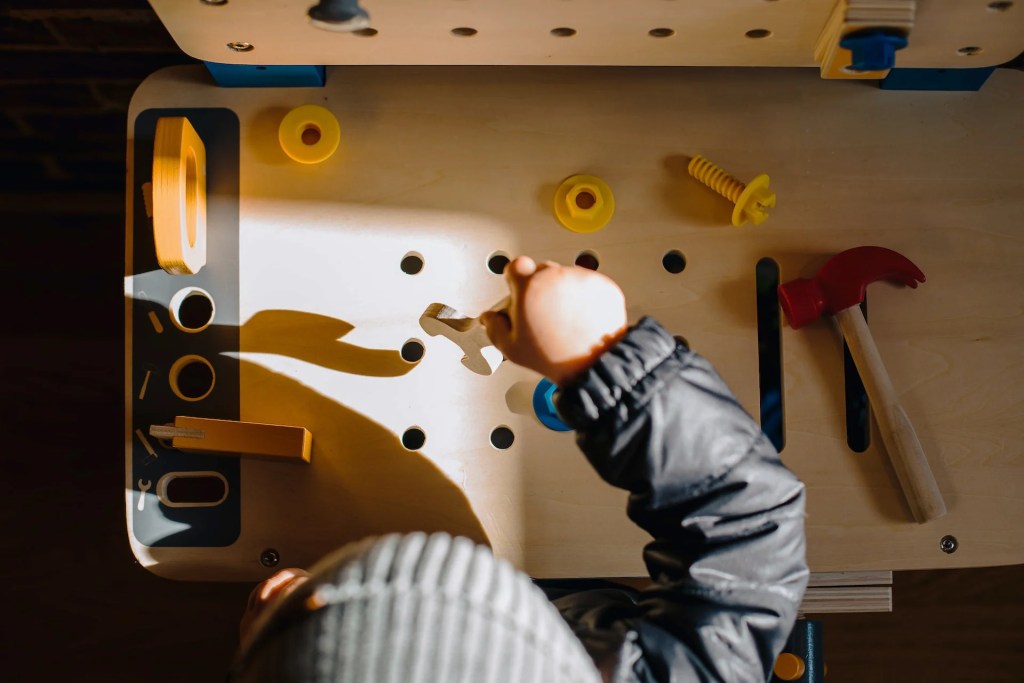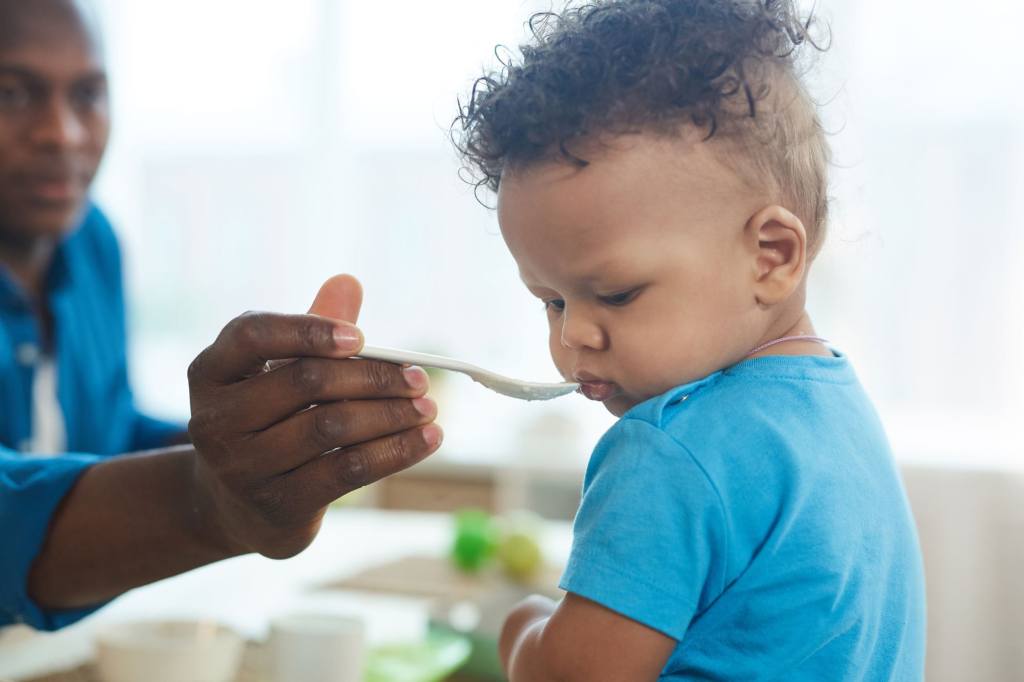Your cart is currently empty!

Preventing the heart-wrenching crying, screaming, reaching, and clinging.
Maybe you’re dropping your toddler off at daycare, maybe you’re leaving them at home with a nanny or with grandma (or even with your partner!) Maybe you are simply walking out of the room that your toddler is in… and what happens? Crying, screaming, reaching, and clinging.
If any of this sounds familiar, you are not alone. This is toddler separation anxiety and it is incredibly common toddler behavior. Before we dive into what to do, let’s talk a little about why this is happening.
Your toddler is (developmentally speaking) fighting an internal “battle” of sorts – on the one hand they’re just beginning to exert their need for autonomy, craving independence, and wanting to do things on their own. This is why you will also hear a lot of “Mine!” and, “No, I do it!” and, “By myself!” during this stage.
Your toddler’s internal drive for independence is a healthy and appropriate one, and yet, at the same time they still very much rely on you and the comfort and safety you provide them. There’s a tug-of-war happening within them: They simultaneously crave independence AND crave your comfort and safety. This is why, at times, they seem so independent and then within an instant can shift to being clingy and attached to you.
In addition, your toddler is still very impulsive, extreme, irrational, and, of course, very emotional. These are not character flaws. These are simply the natural characteristics of young children who are still in the process of growing and developing.
Your toddler is reacting to the immediate trigger of you leaving because they’re not yet able to contain their emotions, use executive reasoning skills, or rely on previous experience.
It’s important to understand that your toddler having somewhat of a hard time when you leave is actually a good thing. It’s a sign of healthy, secure attachment. They rely on your love and support and miss you when you’re gone, so, of course, they will express some feelings when you leave.
I want you to know and trust that it’s not “bad” if your toddler cries when you leave their side. Your toddler’s emotions are not something you need to fear or avoid. Still, what you’re looking to achieve is balance.
What I mean is that while, yes, it’s okay for your child to have a hard time when you leave, you also want them to be able to recover from those feelings in a reasonable amount of time. It’s the recovery that is key. That’s the “balance” you’re looking for.
Leaving The House
Unfortunately for your little one, you do have to leave sometimes. You’re going to work, to the store… anywhere that’s not home. You’re leaving your toddler with someone they know and trust (nanny, grandma, uncle, friend, your partner, and so on), and still, they’re having a hard time.
Remember, it’s okay for your child to fully express themselves with no shame or judgment and you don’t have to stop or fix your child’s feelings.
Keep Calm
Keep it brief, simple, and most of all, calm. No drama or panic:
- “I’m going to the store now. You are staying here with Grandpa. I will be back a little later.”
- “Time for me to go to work now. You will stay at home with X and I will see you when I come back.”
Validate The Feelings
“You might miss me, you might feel a little sad and cry when I go. It’s okay to cry. I will miss you too. When I’m not here, Grandpa takes care of you… he hugs you, feeds you, and holds your hand when you go for a walk. And then… I come back :)”
Avoid making promises, bargaining, over-explaining, or building up your return as a “prize”. Then, calmly and confidently leave without adding any panic or “drama” of your own. The next step is key! And it’s the one that doesn’t get talked about. What is happening in your home after you leave?
Reassure and Encourage
This is what your partner, nanny, grandpa, etc. are doing once you leave.
Reassure:
- “Mommy / Daddy always come back. She/He is not here right now and that’s hard for you…you’re sad and you miss her/him. That’s okay. I know she/he misses you too.”
- “Do you know where mommy/daddy is right now? I can tell you…she got in her car. What color is Mommy’s car? That’s right, black 🙂 She drove…Do you think she honked the horn?”
- “She’s driving and maybe on the way she’ll see…some trees, other cars…what else? And when she’s all done, where will she go? That’s right, she’ll come back home.”
This script above is, of course, just an example, but the idea remains the same. You’re engaging your toddler’s senses and their ability to recall memories. You’re using clear and direct language and even humor. And above all, you’re being authentic.
Encourage:
“While mommy is at the store, who is taking care of you? Me! If you’re thirsty I will give you water. If you’re sad I can hug you. What shall we play when you’re feeling a little better?”
Throughout these 3 steps, you are not trying to avoid your child’s emotions. You are not trying to distract your child or make them “forget” their feelings or that you left.
- You are emotionally supporting your toddler while they are struggling so that they can strengthen their coping skills and expand their trust.
- You are communicating in a way they can fully understand and relate to and including them in the conversation.
- You are helping them process what’s happening and how they’re feeling about it until the feelings naturally pass on their own (and every feeling eventually passes, the “good” ones and the “bad” ones)
- You are taking your time and not rushing.
- You are trusting in your toddler’s ability (and your own!) to cope and build resilience.
When You Can’t Leave The Room
What if your toddler begins to cry and clings to you as soon as you try to leave the room? This happens frequently with younger toddlers. You’re at home, playing together and you attempt to walk to the bathroom or the kitchen and…instant tantrum.
Toddlers are incredibly sensory, taking in and learning about the world around them by using their senses: touch, sight, smell, hearing, and taste.
It’s why they love to play with their food, why they put everything in their mouths, why they love getting messy and painting, splashing, manipulating play dough, sand or mud, and so on. It’s precisely these senses you’re going to use to help your toddler by “switching” one sense with another.
When your toddler cries the second you leave the room, to them it’s as if once you leave, you are gone. If they can no longer see you with their eyes, you must not be there.
You know that’s not the case and so you try to explain to your toddler using your logic and reason: “But, I’m still here… I’m only going to the kitchen…” Your explanations make perfect sense to you. They don’t make sense to your toddler.
So what do you do instead?
You’re going to play a game with your toddler (not while they’re crying, but during a calm moment) and in this game, you’ll practice switching between their 2 senses of sight and sound using the common “peek-a-boo” style game. Here’s what I mean.
Cover your face and have your toddler mimic you: “Can’t SEE me… But can you hear me? With your ears? YES! Can’t see me with your eyes, but you can hear me with your ears!”
Repeat this game a few times at your leisure. You can also play “You can see the truck, here it is.” Put the toy behind your back. “Can’t see the truck anymore, but can you hear it? What was that sound? Yeah, that’s the truck! You can’t see it but you can hear it with your ears.” You will now “level up” the game and begin to leave the room.
“Mommy is going to the kitchen… You stay here. Can’t see Mommy…Can you hear Mommy? Can’t SEE mommy with your eyes… I’m talking… I’m singing and you can hear me with your ears 🙂 You can hear me make a silly sound…”
If at first your child cries or runs after you, stay calm and don’t panic. If you’re able to have someone stay in the room with them while you practice, go ahead and try that. If not, that’s also ok. Take a break and try again a little later. Your calmness and consistency throughout the process are key.
Continue to practice this “game” a few times as you feel necessary. Some toddlers take to it on the first couple tries and some may take a few days of practicing.
Playgrounds, Play Dates, Activities, Classes, Parties, Etc.
You’re out and about with your toddler, at the park, at a toddler music class… and you find that they are clinging to you and not willing to socialize or explore the surroundings. This can be especially
common when you’re taking your toddler to new places, possibly crowded with new people.
Let’s look at this from your toddler’s point of view. If you’re in a new place with some new faces, it’s not surprising that your child may need to take some time to process all this new stimulation before feeling more comfortable to explore and socialize.
And if you’re not in a new place and your toddler is still staying close to you? Not a problem. How each individual naturally socializes is innate and part of their core personality. Your goal is not to change your child’s nature, your goal is to guide them to make the most of who they naturally are.
So it’s not about your toddler being “too shy” and it’s definitely not about them being antisocial or “rude”. It’s about their personal, innate level of comfort that over time can expand with trust, experience, and your supportive guidance.
(and that’s why, you actually don’t have to do much (good news!) )
- “l can see you want to be close to mommy/daddy right now.” or “Looks like you’re not ready yet to go and play.”
- “That’s okay. You can stay right here with me”.
- “Sometimes we need to take our time. Let’s take our time and be here together until you are ready to do something else”. or “Take your time and when you’re ready, you can let me know what you want to do.”
Notice that in step 1, you’re using the words, “right now.” Using “right now” helps you reframe your own possible fear and anxiety. It reminds you how your child is not always shy or always clinging to you. They are shy “right now”, at this moment. What they are experiencing is in the present time. It does not mean it’s permanent or irreparable.
Even if it may feel as if your toddler is always a certain way, there are moments when your toddler is not shy and not clingy… at home, with family, siblings and so on.
In addition, you want to avoid labeling your child. Help them by bringing attention to the fact that what they’re feeling is a passing emotion and not a permanent character trait.
Parent Preferences
Toddler parent preference can sound like: “Nooo! Mommy do it!” or “l want daddy to get my milk!”
Know that when you’re faced with your toddler seemingly “preferring” one parent and “rejecting” another, this is totally normal and typical toddler behavior. And when handled well, it’s a short phase. Your biggest tool is your calmness.
Don’t take it personally. Truly, don’t take it personally. Please know that your child is not “rejecting” you. Your child is learning to make choices and decisions, to assert their opinion, and even to explore control, all part of their emerging healthy independence.
If you feel especially triggered by your toddler “picking and choosing” one parent over another, it may be a sign for you to explore these feelings on a deeper level, as they may be a reminder of other “rejections” you have experienced.
- “You want mommy to give you a bath, I hear you” or “You want daddy to pick you up.”
- “You love daddy/mommy, I know. She/he loves you too.”
- “Right now, mommy is picking you up.” or “Today, daddy is doing the bath. Let’s go turn the water on.”
If you are the “chosen” parent, be sure to validate and acknowledge the other parent, the “rejected” one, and remind them your child’s behavior is not a sign of their love, but of their new sense of assertion and control.
If you find your toddler is being physical: pushing you away or hitting you be sure to encourage appropriate communication:
Your toddler hitting, biting, pushing, pinching you, other kids or even themselves is considered typical toddler behavior. While typical, it’s still very important that you respond appropriately so the behaviors don’t unnecessarily escalate. “Don’t do that!” or “You’re hurting me!” is not enough. For exactly what you can say and do (including scripts, intonation, body language) Check out my Everything Toddler Course.
School & Daycare
School is a wonderful thing. But school (or daycare drop-off can be a huge source of anxiety for both you and your toddler. It’s a big transition that can evoke feelings of fear, uncertainty, and insecurity.
The first thing you need to know is that all of these feelings are perfectly natural for your toddler to feel and that is precisely why you don’t have to try and avoid them or dismiss them. Your toddler crying, even screaming and clinging to you on the first few days of school drop-off is not an indication that there is something wrong with your child or that you are doing something wrong by sending them to school (or daycare), it’s an indication that your toddler is openly expressing themselves the only way they know how… and that’s perfectly ok.
Instead of avoiding or tip-toeing around the feelings your child will likely have at drop off, address them head-on by preparing your child for the upcoming transition of starting school. You’re not trying to “sell” your toddler on all the fun they’ll be having. You are addressing your child’s fundamental need to feel safe and secure.
INSTEAD OF: “You’ll have so much fun! You’ll play! You’ll make so many friends.”
TRY: “Who takes care of you at home? I do 🙂 That’s right. If you need a hug, I’m here to give you one…If you’re hungry, I give you food…we play together, remember how we played with your blue truck? Yeah…and when you are at school, who takes care of you there? Your teacher does.”
“What does that mean? Your teacher will…give you water when you’re thirsty… hold your hand and hug you if you’re feeling sad… play with you..read a book to you. I take care of you at home and your teacher takes care of you at school.”
This is an important distinction. Your child’s main concern or hesitation is about security and who will care for them in your absence. It’s NOT about who they will play with and all the fun they will have. It’s only when they feel safe that they can begin to think about the other things like who they will play with etc. First comes the basic needs of safety and security, then comes joy and happiness.
“You might cry and miss me when we say goodbye. It’s okay to cry. It’s okay to miss me. Do you know why we cry sometimes when we say goodbye? Because we love each other. Yea… That’s a good thing. Do I miss you too? Of course! So if you need to cry and feel sad, it’s ok, and your teacher will hug you and say, it’s okay to be sad when you miss mommy/daddy…
And don’t forget to encourage coping skills:
“When you’re done crying… what do you think you’ll do then? Maybe play with the…”
You’re showing your toddler they are the ones in charge of their emotions, not you.
On the first few days of drop-off, you will reiterate exactly what you have been discussing, keeping it calm, short, and simple with no panic or drama. Work to manage your own emotions and possible feelings of anxiety or guilt and trust that both you and your child will be okay.
“Here we are 🙂 Remember, at school, your teacher takes care of you and I will be back to pick you up later.”
- Notice that in all these scenarios discussed you are in control of your emotions. It’s not always easy. Still, it’s absolutely possible and worth it, with tons of practice and trial and error. Don’t forget to show yourself the same patience and empathy you show your child.
- Notice you’re not dismissing or minimizing your child’s feelings: “Why are you crying? Don’t cry… You’ll have so much fun. You know grandma… Stop it..”
- Notice there’s no pleading: “I’ll be right back! It’s ok! You’re going to be okay! I’ll be right back, I promise!”
- Notice you’re not using guilt or shame: “You want me to go to work, don’t you, so I can buy you all these great toys… Don’t you want to be at school playing with your friends? Look at all the other kids here, no one is crying… why are you?”
- Notice you’re not making your child responsible for your feelings: “Don’t be sad… now you’re making me sad… you have to stay strong for mommy… this is so hard for me, why are you making it so hard?”
- Notice you’re not asking too many questions: “Why don’t you want me to give you a bath? I always give you a bath? Don’t you want me to? We have so much fun..”










